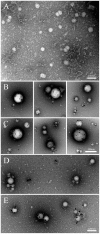Syncytiotrophoblast vesicles show altered micro-RNA and haemoglobin content after ex-vivo perfusion of placentas with haemoglobin to mimic preeclampsia
- PMID: 24587192
- PMCID: PMC3937405
- DOI: 10.1371/journal.pone.0090020
Syncytiotrophoblast vesicles show altered micro-RNA and haemoglobin content after ex-vivo perfusion of placentas with haemoglobin to mimic preeclampsia
Abstract
Background: Cell-free foetal haemoglobin (HbF) has been shown to play a role in the pathology of preeclampsia (PE). In the present study, we aimed to further characterize the harmful effects of extracellular free haemoglobin (Hb) on the placenta. In particular, we investigated whether cell-free Hb affects the release of placental syncytiotrophoblast vesicles (STBMs) and their micro-RNA content.
Methods: The dual ex-vivo perfusion system was used to perfuse isolated cotyledons from human placenta, with medium alone (control) or supplemented with cell-free Hb. Perfusion medium from the maternal side of the placenta was collected at the end of all perfusion phases. The STBMs were isolated using ultra-centrifugation, at 10,000×g and 150,000×g (referred to as 10K and 150K STBMs). The STBMs were characterized using the nanoparticle tracking analysis, identification of surface markers and transmission electron microscopy. RNA was extracted and nine different micro-RNAs, related to hypoxia, PE and Hb synthesis, were selected for analysis by quantitative PCR.
Results: All micro-RNAs investigated were present in the STBMs. Mir-517a, mir-141 and mir-517b were down regulated after Hb perfusion in the 10K STBMs. Furthermore, Hb was shown to be carried by the STBMs.
Conclusion: This study showed that Hb perfusion can alter the micro-RNA content of released STBMs. Of particular interest is the alteration of two placenta specific micro-RNAs; mir-517a and mir-517b. We have also seen that STBMs may function as carriers of Hb into the maternal circulation.
Conflict of interest statement
Figures



Similar articles
-
Reduced placental protein 13 (PP13) in placental derived syncytiotrophoblast extracellular vesicles in preeclampsia - A novel tool to study the impaired cargo transmission of the placenta to the maternal organs.Placenta. 2018 Jun;66:17-25. doi: 10.1016/j.placenta.2018.04.013. Epub 2018 Apr 25. Placenta. 2018. PMID: 29884298
-
Multicolor flow cytometry and nanoparticle tracking analysis of extracellular vesicles in the plasma of normal pregnant and pre-eclamptic women.Biol Reprod. 2013 Dec 26;89(6):151. doi: 10.1095/biolreprod.113.113266. Print 2013 Dec. Biol Reprod. 2013. PMID: 24227753
-
Placental hypoxia inducible factor -1α & CHOP immuno-histochemical expression relative to maternal circulatory syncytiotrophoblast micro-vesicles in preeclamptic and normotensive pregnancies.Eur J Obstet Gynecol Reprod Biol. 2018 Jan;220:18-24. doi: 10.1016/j.ejogrb.2017.11.004. Epub 2017 Nov 7. Eur J Obstet Gynecol Reprod Biol. 2018. PMID: 29127866
-
The roles of free iron, heme, haemoglobin, and the scavenger proteins haemopexin and alpha-1-microglobulin in preeclampsia and fetal growth restriction.J Intern Med. 2021 Nov;290(5):952-968. doi: 10.1111/joim.13349. Epub 2021 Jul 6. J Intern Med. 2021. PMID: 34146434 Review.
-
TGFβ signalling: a nexus between inflammation, placental health and preeclampsia throughout pregnancy.Hum Reprod Update. 2024 Jul 1;30(4):442-471. doi: 10.1093/humupd/dmae007. Hum Reprod Update. 2024. PMID: 38519450 Free PMC article. Review.
Cited by
-
Extracellular vesicles and reproduction-promotion of successful pregnancy.Cell Mol Immunol. 2014 Nov;11(6):548-63. doi: 10.1038/cmi.2014.42. Epub 2014 Jun 23. Cell Mol Immunol. 2014. PMID: 24954226 Free PMC article. Review.
-
Micro- and Nano-vesicles from First Trimester Human Placentae Carry Flt-1 and Levels Are Increased in Severe Preeclampsia.Front Endocrinol (Lausanne). 2017 Jul 24;8:174. doi: 10.3389/fendo.2017.00174. eCollection 2017. Front Endocrinol (Lausanne). 2017. PMID: 28790977 Free PMC article.
-
Large-scale transcriptome-wide profiling of microRNAs in human placenta and maternal plasma at early to mid gestation.RNA Biol. 2021 Oct 15;18(sup1):507-520. doi: 10.1080/15476286.2021.1963105. Epub 2021 Aug 19. RNA Biol. 2021. PMID: 34412547 Free PMC article.
-
Syncytiotrophoblast extracellular vesicles - Circulating biopsies reflecting placental health.Placenta. 2017 Apr;52:134-138. doi: 10.1016/j.placenta.2016.11.008. Epub 2016 Nov 16. Placenta. 2017. PMID: 27899180 Free PMC article. Review.
-
Characterization of intravascular cellular activation in relationship to subclinical atherosclerosis in postmenopausal women.PLoS One. 2017 Sep 14;12(9):e0183159. doi: 10.1371/journal.pone.0183159. eCollection 2017. PLoS One. 2017. PMID: 28910282 Free PMC article.
References
Publication types
MeSH terms
Substances
Grants and funding
LinkOut - more resources
Full Text Sources
Other Literature Sources

